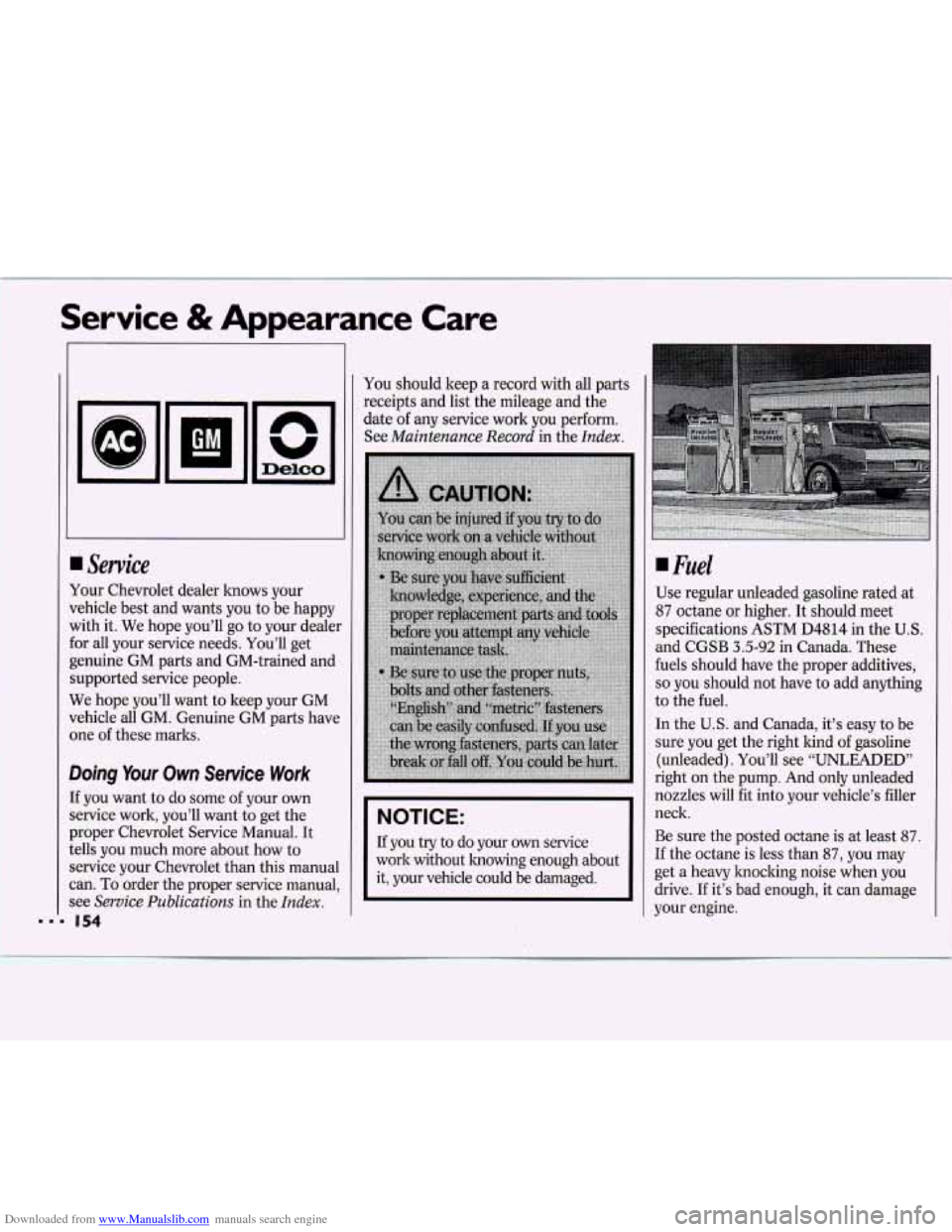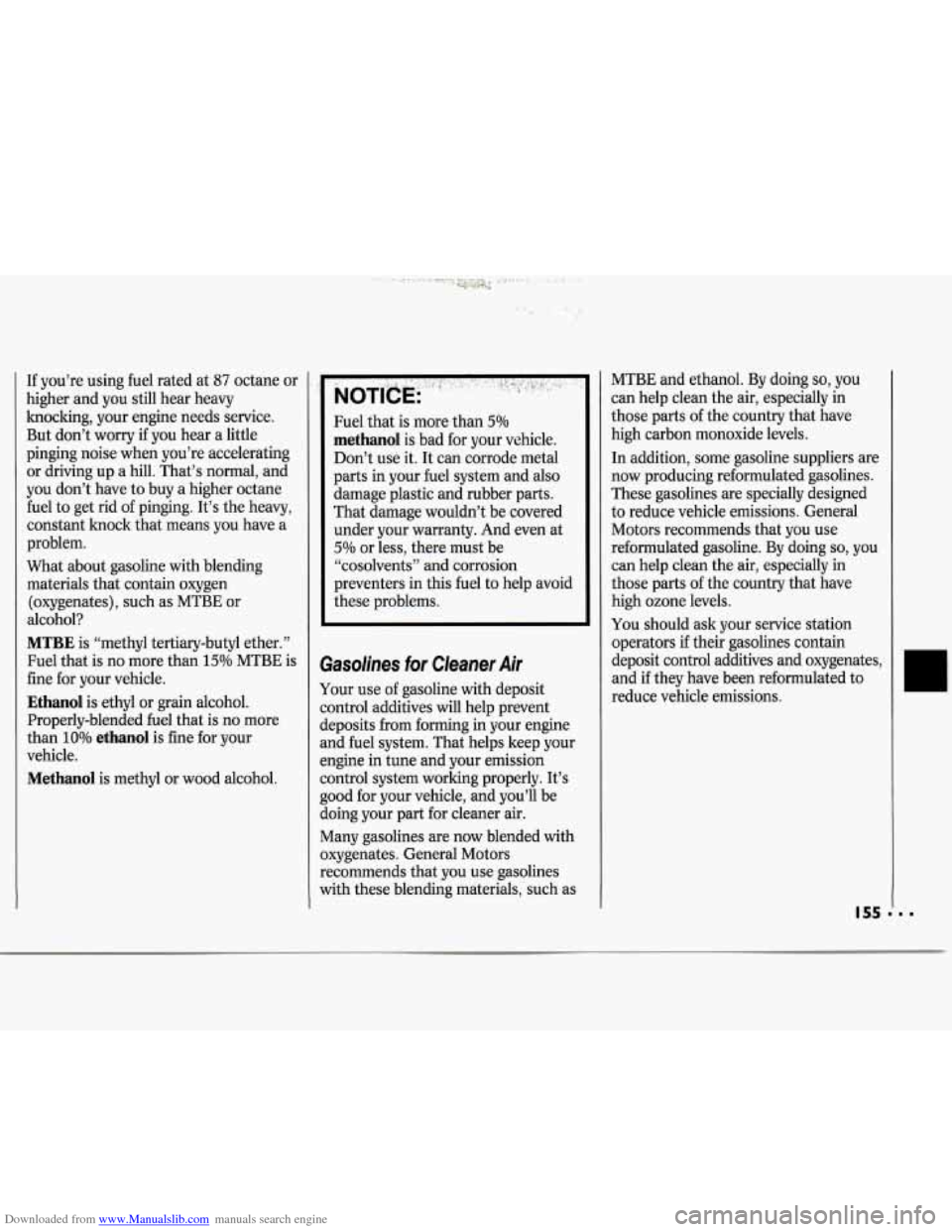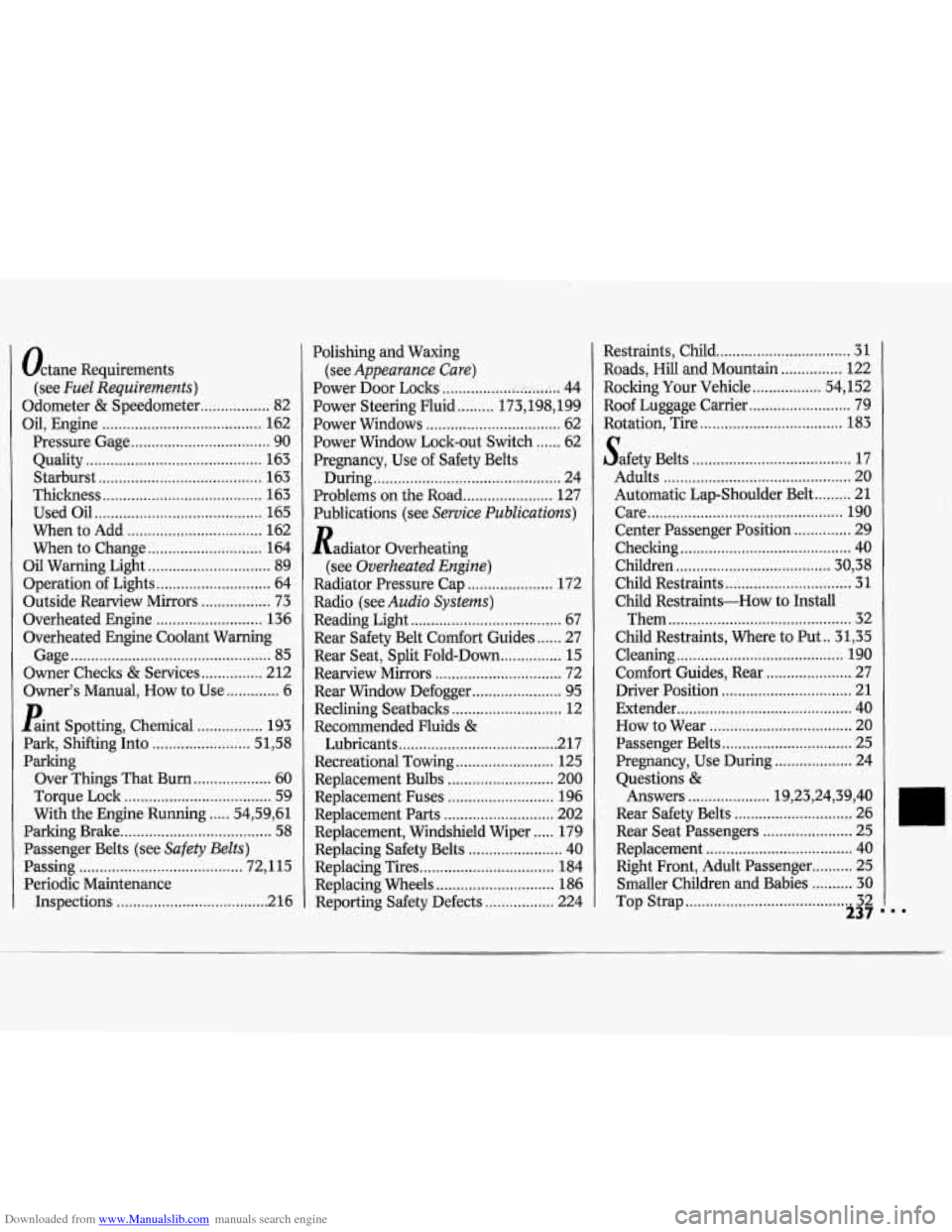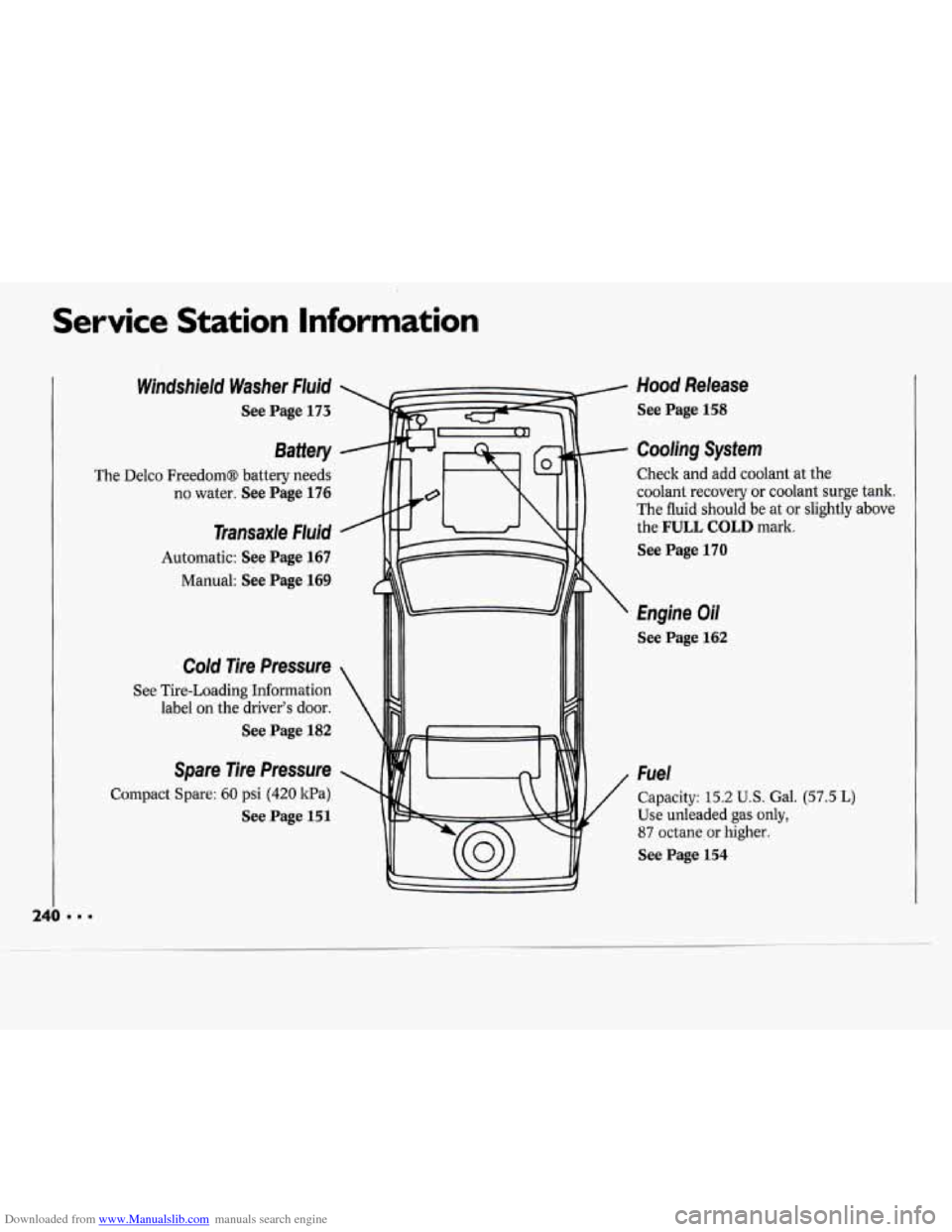1994 CHEVROLET CAVALIER octane
[x] Cancel search: octanePage 155 of 243

Downloaded from www.Manualslib.com manuals search engine Service & Appearance Care
.I I.
Service
Your Chevrolet dealer knows your
vehicle best and wants you to be happy
with it. We hope you’ll go to your dealer
for all your service needs. You’ll get
genuine GM parts and GM-trained and
supported service people.
We hope you’ll want to keep your GM
vehicle all GM. Genuine GM parts have
one of these marks.
Doing Your Own Service Work
If you want to do some of your own
service work, you’ll want to get the
proper Chevrolet Service Manual. It
tells you much more about how to
service your Chevrolet than this manual
can. To order the proper service manual,
see
Service Publications in the Index.
I54
You should keep a record with all parts
receipts and list the mileage and the
date of any service work you perform.
See
Maintenance Record in the Index.
NOTICE:
If you try to do your own service
work without knowing enough about
it, your vehicle could be damaged.
Fuel
Use regular unleaded gasoline rated at
87 octane or higher. It should meet
specifications ASTM D4814 in the
U.S.
and CGSB 3.5-92 in Canada. These
fuels should have the proper additives,
so you should not have to add anything
to the fuel.
In the
U.S. and Canada, it’s easy to be
sure you get the right kind of gasoline
(unleaded). You’ll see “UNLEADED”
right on the pump. And only unleaded
nozzles will fit into your vehicle’s filler
neck.
Be sure the posted octane is at least
87.
If the octane is less than 87, you may
get a heavy knocking noise when you
drive.
If it’s bad enough, it can damage
your engine.
Page 156 of 243

Downloaded from www.Manualslib.com manuals search engine If you’re using fuel rated at 87 octane or
higher and you still hear heavy
knocking, your engine needs service.
But don’t worry
if you hear a little
pinging noise when you’re accelerating
or driving up a hill. That’s normal, and
you don’t have to buy a higher octane
fuel to get rid of pinging. It’s the heavy,
constant knock that means you have a
problem.
What about gasoline with blending
materials that contain oxygen
(oxygenates), such as MTBE or
alcohol?
MTBE is “methyl tertiary-butyl ether.”
Fuel that is no more than
15% MTBE is
fine for your vehicle.
Ethanol is ethyl or grain alcohol.
Properly-blended fuel that is no more
than
10% ethanol is fine for your
vehicle.
Methanol is methyl or wood alcohol. Fuel
that is more than
5%
methanol is bad for your vehicle.
Don’t use it. It can corrode metal
parts in your fuel system and also
damage plastic and rubber parts.
That damage wouldn’t be covered
under your warranty. And even at
5% or less, there must be
“cosolvents” and corrosion
preventers in this fuel to help avoid
these problems.
Gasolines for Cleaner Air
Your use of gasoline with deposit
control additives will help prevent
deposits from forming in your engine
and fuel system. That helps keep your
engine in tune and your emission
control system working properly. It’s
good for your vehicle, and you’ll be
doing your part for cleaner air.
Many gasolines are now blended with
oxygenates. General Motors
recommends that you use gasolines
with these blending materials, such as
MTBE and ethanol. By doing so, you
can help clean the air, especially in
those parts of the country that have
high carbon monoxide levels.
In addition, some gasoline suppliers are
now producing reformulated gasolines.
These gasolines are specially designed
to reduce vehicle emissions. General
Motors recommends that you use
reformulated gasoline. By doing
so, you
can help clean the air, especially in
those parts of the country that have
high ozone levels.
You should ask your service station
operators if their gasolines contain
deposit control additives and oxygenates,
and if they have been reformulated to
reduce vehicle emissions.
Page 238 of 243

Downloaded from www.Manualslib.com manuals search engine Octane Requirements
Odometer
& Speedometer ................. 82
(see
Fuel
Requirements)
Oil. Engine ....................................... 162
Pressure Gage
.................................. 90
Quality
........................................... 163
Starburst
........................................ 163
Thickness
....................................... 163
Used Oil
......................................... 165
When
to Add ................................. 162
When to Change
............................ 164
Oil Warning Light
.............................. 89
Operation of Lights
............................ 64
Outside Rearview Mirrors
................. 73
Overheated Engine
.......................... 136
Overheated Engine Coolant Warning Gage
................................................. 85
Owner Checks & Services ............... 212
Owner’s Manual. How to Use
............. 6
paint Spotting. Chemical
................ 193
Park. Shifting Into
........................ 51. 58
Parking
Over Things That Burn
................... 60
With the Engine Running
..... 54.59. 61
Passing
........................................ 72. 115
Inspections
..................................... 2 16
Torque
Lock
.................................... 59
Parking Brake
..................................... 58
Passenger Belts (see Safety Belts)
Periodic Maintenance Polishing
and Waxing
Power Door Locks
................. i. ........ ;. 44
Power Steering Fluid
......... 173,198, 199
Power Windows
................................. 62
Power Window Lock-out Switch
...... 62
Pregnancy, Use of Safety Belts
During
.............................................. 24
Problems on the Road
...................... 127
Publications (see
Service Publications)
Radiator Overheating
(see
Overheated Engine)
Radiator Pressure Cap ..................... 172
Radio (see
Audio Systems)
Reading Light ..................................... 67
Rear Safety Belt Comfort Guides
...... 27
Rear Seat, Split Fold-Down
............... 15
Rearview Mirrors ............................... 72
(see
Appearance
Care)
Rear Window Defogger ...................... 95
Reclining Seatbacks
........................... 12
Recreational Towing
........................ 125
Recommended Fluids
&
Lubricants ....................................... 217
Replacement Bulbs
.......................... 200
Replacement Fuses
.......................... 196
Replacement Parts
........................... 202
Replacement, Windshield Wiper
..... 179
Replacing Safety Belts
....................... 40
Replacing Tires
................................. 184
Reporting Safety Defects
................. 224
Replacing Wheels
............................. 186
Restraints. Child ................................. 31
Roads. Hill and Mountain
............... 122
Rocking Your Vehicle
................. 54. 152
Rotation. Tire
................................... 183
Roof Luggage
Carrier
......................... 79
S afety Belts ....................................... 17
Adults .............................................. 20
Automatic Lap-Shoulder Belt
......... 21
Care
................................................ 190
Center Passenger Position
.............. 29
Checking
.......................................... 40
Children
...................................... 3 0, 38
Child Restraints
............................... 31
Child Restraints-How to Install
Them
............................................. 32
Child Restraints, Where to Put
.. 31, 35
Cleaning
......................................... 190
Comfort Guides, Rear
..................... 27
Driver Position
................................ 21
Extender
........................................... 40
How to Wear ................................... 20
Passenger Belts
................................ 25
Pregnancy, Use During
................... 24
Questions
&
Answers .................... 19,23,24,39, 40
Rear Safety Belts ............................. 26
Rear Seat Passengers
...................... 25
Right Front, Adult Passenger
.......... 25
Smaller Children and Babies
.......... 30
Replacement .................................... 40
Top Strap
......................................... 32
237
Page 241 of 243

Downloaded from www.Manualslib.com manuals search engine Service Station Information
Windshield Washer Fluid
See Page 173
Battery
The Delco Freedom03 battery needs
no water.
See Page 176
Transaxle Fluid
Automatic: See Page 167
Manual: See Page 169
Cold Tire Pressure
See Tire-Loading Information
label
on the driver’s door.
See Page 182
Spare Tire Pressure
Compact Spare: 60 psi (420 1tPa)
See Page 151
Hood Release
See Page 158
Cooling System
Check and add coolant at the
coolant recovery or coolant surge tank.
The fluid should be at or slightly above
the
FULL COLD mark.
See Page 170
Engine Oil
See Page 162
Fuel
Capacity: 15.2 U.S. Gal. (57.5 L)
Use unleaded gas only,
87 octane or higher.
See Page 154